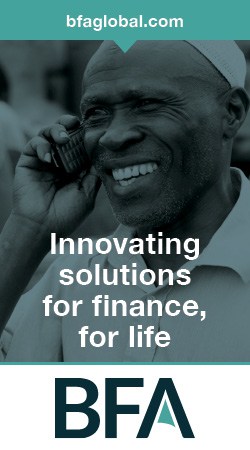The Superplatforms are Coming … And They Will Transform Financial Inclusion
For decades experts have claimed that banks are dead or dying, but they have persisted. However, the entrance of new internet giants or “superplatforms” into financial services may finally spell doom for some traditional financial institutions.
 In the 1990s, some expected that large retailers, like Sainsburys in the U.K. or Walmart in the U.S., would strike a deadly blow to retail banking with their widespread distribution networks and trusted brands. But independent, retailer-driven financial services have remained the exception, not the norm. In the 2000s, many predicted that mobile network operators (MNOs) would “eat the banks’ lunch,” especially in developing markets with limited bank presence. In a few countries like Kenya, MNOs have indeed enjoyed a financial feast – but again, those markets have been the exception; for most MNOs, the financial pickings have been slim. More recently, the power of internet-based technologies coalesced into a seemingly mighty wave of fintech startups that were predicted to overwhelm the breakwaters of incumbency; but this has yet to happen and may never. Now, attention is on forms of cooperation between banks and fintechs, much as it was with retailers before them, thereby keeping banks at or near the center of financial inclusion.
In the 1990s, some expected that large retailers, like Sainsburys in the U.K. or Walmart in the U.S., would strike a deadly blow to retail banking with their widespread distribution networks and trusted brands. But independent, retailer-driven financial services have remained the exception, not the norm. In the 2000s, many predicted that mobile network operators (MNOs) would “eat the banks’ lunch,” especially in developing markets with limited bank presence. In a few countries like Kenya, MNOs have indeed enjoyed a financial feast – but again, those markets have been the exception; for most MNOs, the financial pickings have been slim. More recently, the power of internet-based technologies coalesced into a seemingly mighty wave of fintech startups that were predicted to overwhelm the breakwaters of incumbency; but this has yet to happen and may never. Now, attention is on forms of cooperation between banks and fintechs, much as it was with retailers before them, thereby keeping banks at or near the center of financial inclusion.
However, the internet giants are now at the door or, in the case of China (as discussed below), way beyond the door. This has profound implications for the future of financial inclusion, because their business models differ from financial service providers that have gone before them. Among the large internet companies are superplatforms or “platforms of platforms” that operate across multiple sectors, even if they dominate just one. What makes a superplatform “super” is not just its size – although seven of the largest companies in the world (as measured by market capitalization) are superplatforms (the U.S. giants Apple, Google, Amazon, Facebook and Microsoft, and Chinese counterparts Alibaba and Tencent) – but rather its ubiquity across sectors. Facebook, for example, dominates social networking and instant messaging (outside of China), but also runs a massive online news aggregation service.
Superplatforms also support a two-way flow, enabling users to be buyers and sellers of goods and services. The superplatforms recognize the importance of extending this cross-sector dominance; Facebook expanded its local e-commerce service Marketplace across Europe in late 2017.
Few would deny that these superplatforms are very good at what they do, and it is clear why they are regularly recognized on lists of the world’s most innovative and client-centric companies. Their core competency, and ultimately their core asset, is data, the oil of the digital age. They already know more about most banks’ customers than the banks themselves, and they have a strong incentive to leverage these informational assets directly to fuel their own growth – or to leverage them indirectly, by selling them.
The Growth of Superplatforms
The rapid growth of the Chinese superplatforms in financial services points to how the world is changing.
The Alibaba Group, China’s largest e-commerce provider, founded Alipay in 2004 to enable escrow and payments for its e-commerce model. Today, Alipay is one of the most widely used retail payment systems in the world, with 450 million active users of its mobile app each month. Alipay’s low merchant fee has placed severe pressure on China’s card market by squeezing the margins of incumbent banks.
In 2014, Alipay was spun-off into the wider financial service group Ant Financial and is now one of the world’s most valuable unlisted fintech companies. Ant’s direct financial offerings include the world’s largest money market fund, Yu’ebao, as well as the wider Ant Fortune marketplace through which Ant’s customers can seamlessly access hundreds of other fund offerings. As clients have flocked to these wealth management vehicles, some banks have lost savings deposits, which typically earn less interest. Ant also owns a large minority stake in MyBank, a private bank licensed in 2014 that reports 3.5 million small business clients and a loan portfolio close to US$5 billion. Although its ecosystem includes a bank, Ant refers to itself as a “techfin” company rather than a fintech company, to highlight that its core proposition is leveraging client data to offer all kinds of services and not the other way around. For example, Ant’s Sesame credit score is widely used beyond credit alone: A high score unlocks benefits like access to hotel rooms without deposits and visa-free travel to certain countries.
Having achieved dominance at home, the Chinese superplatforms are now turning their attention globally. Together with arch-competitor Tencent Holdings, Ant Financial has announced plans to grow offshore. The founder of Alibaba, Jack Ma, captured public attention by announcing their goal of becoming the world’s fifth-largest economy in the next 20 years; serving 2 billion customers globally, creating 100 million job opportunities, and enabling 10 million businesses. In 2017, Ant bought and rebranded a payment business in South East Asia and launched an attempted takeover bid for Moneygram, the second largest remittance company in the world (the takeover collapsed after a U.S. government panel rejected it due to national security concerns). In Africa, Alipay became available to Chinese tourists in South Africa in 2017 and Jack Ma’s much-publicized visit to Kenya in July 2017 was accompanied by speculation that further rollout on the continent would follow. Tencent has been slower to internationalize, but partnered with Standard Bank in 2015 to offer WeChatpay in South Africa.
Opportunities in Financial Services
Superplatforms are entering financial services with big brands, big budgets and big data.
The prevailing paradigm of traditional banks can be characterized as “supply-push,” in which financial providers, whether banks or mobile operators, reach out to offer their services to an underserved public. Traditional financial services are not “demand-pull;” underserved people don’t generally queue up for formal services of their own accord except when governments aid the inclusion push by digitizing government payments.
Ultimately, traditional financial services don’t really solve the main economic problems that lower-income people face: to generate more income and to stabilize their sources of liquidity to match their life circumstances. Furthermore, they are not always customer friendly. These basic problems are not solved by a basic bank account, a mobile money account or even a bank loan (assuming one were available).
In contrast, superplatforms don’t offer financial services as the essential entry product, but rather as an enabler for other desirable things—often as a corollary to some income generating activity, such as selling goods or labor through their platforms. Of course, these engagements generate a data record that may help make users worthy of traditional credit, or they may lead to another service like “bite-sized” insurance. In addition, superplatforms already have extensive social networks that enable digital “liquidity farming,” by tapping networks of friends and family to meet cash flow crunches. As such, superplatforms may be able to deliver financial inclusion in a way that traditional financial providers have not.
Note: This post is one of NextBillion’s 12 most influential posts of 2018.
David Porteous is the CEO of BFA (a NextBillion partner), and Olga Morawcynski is a project manager at MasterCard Foundation (MCF). This blog draws on a longer report from the FIBR Project supported by MCF called “Inclusive Digital Ecosystems of the Future,” published in early December 2017.
- Categories
- Finance, Technology
- Tags
- data, financial inclusion, fintech



